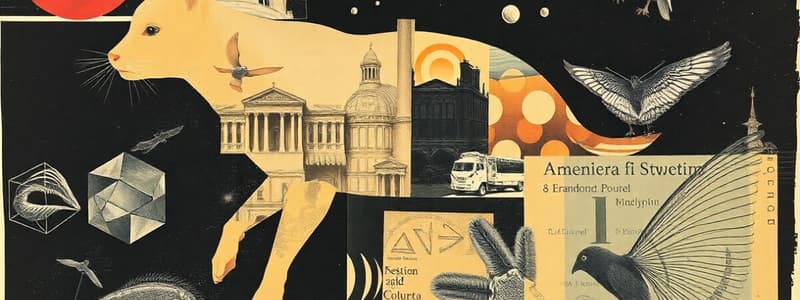Podcast
Questions and Answers
Which of the following is NOT a basic human sense?
Which of the following is NOT a basic human sense?
- Smell
- Balance (correct)
- Taste
- Hearing
What does the term 'sensation' refer to?
What does the term 'sensation' refer to?
- The process of picking up sensory stimuli and sending them to the brain (correct)
- The process of organizing and interpreting information
- The process of interpreting sensory information
- The conscious experience of the world around us
Why is understanding sensory systems important?
Why is understanding sensory systems important?
- Sensory systems are not important, they are just basic biological functions
- Sensory systems determine how we interact with the world and influence all cognitive processes (correct)
- Sensory systems are only important for learning new information.
- Sensory systems are only important for animals who rely on them for survival
Which of the following is an example of how sensory systems have adapted in different species?
Which of the following is an example of how sensory systems have adapted in different species?
How do humans perceive color?
How do humans perceive color?
Why is it important to consider sensory evolution across different species?
Why is it important to consider sensory evolution across different species?
Which of the following is an example of how sensory systems are influenced by the environment?
Which of the following is an example of how sensory systems are influenced by the environment?
Which senses are directly affected by the electromagnetic spectrum?
Which senses are directly affected by the electromagnetic spectrum?
What is the process of converting physical input from the environment into electrical signals in the nervous system called?
What is the process of converting physical input from the environment into electrical signals in the nervous system called?
How does the nervous system ensure that sensory information from different modalities (e.g., vision, hearing) doesn't get 'scrambled' as it's sent to the brain?
How does the nervous system ensure that sensory information from different modalities (e.g., vision, hearing) doesn't get 'scrambled' as it's sent to the brain?
What is the main difference between a sensation and a perception?
What is the main difference between a sensation and a perception?
Which of these is NOT a component of the sensory processing system?
Which of these is NOT a component of the sensory processing system?
According to the passage, which sensory modality is considered the most complex?
According to the passage, which sensory modality is considered the most complex?
Which of the following is the best example of a sensation?
Which of the following is the best example of a sensation?
Which of the following would be considered an example of sensory detection?
Which of the following would be considered an example of sensory detection?
What is the primary reason why psychophysics researchers study the relationship between sensations and perceptions?
What is the primary reason why psychophysics researchers study the relationship between sensations and perceptions?
The Compensatory Plasticity Hypothesis suggests that:
The Compensatory Plasticity Hypothesis suggests that:
Why is it difficult to test sensory perception in animals that cannot provide verbal responses?
Why is it difficult to test sensory perception in animals that cannot provide verbal responses?
What is the key difference between natural selection and compensatory plasticity?
What is the key difference between natural selection and compensatory plasticity?
Why are sensitive periods important for the development of sensory systems?
Why are sensitive periods important for the development of sensory systems?
If a sensory system is blocked during development, what does the Compensatory Plasticity Hypothesis predict might happen?
If a sensory system is blocked during development, what does the Compensatory Plasticity Hypothesis predict might happen?
Which of the following is NOT a stage in sensory system function?
Which of the following is NOT a stage in sensory system function?
Which of the following is a factor that influences the development of sensory systems?
Which of the following is a factor that influences the development of sensory systems?
The statement 'Nature AND Nurture!' in the summary underscores the importance of:
The statement 'Nature AND Nurture!' in the summary underscores the importance of:
What does the Just Noticeable Difference (JND) measure?
What does the Just Noticeable Difference (JND) measure?
According to Weber's Law, how is the difference threshold related to the original stimulus?
According to Weber's Law, how is the difference threshold related to the original stimulus?
What is the ratio between the intensity change required for a JND and the original stimulus value called?
What is the ratio between the intensity change required for a JND and the original stimulus value called?
What is the purpose of measuring the difference threshold in perception?
What is the purpose of measuring the difference threshold in perception?
What happens to the JND as the intensity of a stimulus increases?
What happens to the JND as the intensity of a stimulus increases?
What does the point of subjective equality (PSE) represent?
What does the point of subjective equality (PSE) represent?
Which statement best describes the interval of uncertainty in relation to the PSE?
Which statement best describes the interval of uncertainty in relation to the PSE?
In the equation expressed by Weber's Law, what does 'k' represent?
In the equation expressed by Weber's Law, what does 'k' represent?
What characterizes better discrimination in sensory perception?
What characterizes better discrimination in sensory perception?
Which of the following is NOT one of the stages of transforming sensations into perception?
Which of the following is NOT one of the stages of transforming sensations into perception?
What does the lateral geniculate nucleus (LGN) primarily process?
What does the lateral geniculate nucleus (LGN) primarily process?
What role does the Superior Colliculus play in visual processing?
What role does the Superior Colliculus play in visual processing?
Cortically blind patients can still demonstrate which ability due to activity in the Superior Colliculus?
Cortically blind patients can still demonstrate which ability due to activity in the Superior Colliculus?
What is the primary function of the Orbitofrontal Cortex in sensory processing?
What is the primary function of the Orbitofrontal Cortex in sensory processing?
Which theorist's ideas primarily developed the Structuralism perspective on perception?
Which theorist's ideas primarily developed the Structuralism perspective on perception?
According to the elemental theories of perception, how are perceptions created?
According to the elemental theories of perception, how are perceptions created?
What concept is being explained by the example of female Zebra finches choosing adorned males for mating, despite the fact that the ornamentation doesn't indicate fitness?
What concept is being explained by the example of female Zebra finches choosing adorned males for mating, despite the fact that the ornamentation doesn't indicate fitness?
What is the main difference between the examples of greylag geese and stickleback fish, in terms of their response to exaggerated stimuli?
What is the main difference between the examples of greylag geese and stickleback fish, in terms of their response to exaggerated stimuli?
How do the findings of Hubel & Wiesel regarding visual deprivation in young monkeys contribute to our understanding of sensory system development?
How do the findings of Hubel & Wiesel regarding visual deprivation in young monkeys contribute to our understanding of sensory system development?
What is the key implication of the experiments conducted by Blakemore on cats exposed to specific visual stimuli during their early life?
What is the key implication of the experiments conducted by Blakemore on cats exposed to specific visual stimuli during their early life?
Which of the following statements is TRUE regarding sensory systems and their development?
Which of the following statements is TRUE regarding sensory systems and their development?
Which statement BEST describes the concept of “Supernormal Stimuli”?
Which statement BEST describes the concept of “Supernormal Stimuli”?
How does the concept of “Sensory Exploitation” relate to the development of sensory systems?
How does the concept of “Sensory Exploitation” relate to the development of sensory systems?
What is the main takeaway regarding the role of experience in sensory system development?
What is the main takeaway regarding the role of experience in sensory system development?
Flashcards
Sensory Exploitation
Sensory Exploitation
A phenomenon where sensory signals used for one purpose are repurposed for another.
Supernormal Stimuli
Supernormal Stimuli
Exaggerated versions of natural stimuli that elicit stronger responses from animals.
Hubel & Wiesel's Work
Hubel & Wiesel's Work
Pioneering research on how visual systems develop and are organized in the brain.
The Five Senses
The Five Senses
Signup and view all the flashcards
Sensitive Period
Sensitive Period
Signup and view all the flashcards
Sensation
Sensation
Signup and view all the flashcards
Visual Deprivation in Kittens
Visual Deprivation in Kittens
Signup and view all the flashcards
Perception
Perception
Signup and view all the flashcards
Cortical Neuron Connections
Cortical Neuron Connections
Signup and view all the flashcards
Enhanced Pattern Detection
Enhanced Pattern Detection
Signup and view all the flashcards
Echolocation
Echolocation
Signup and view all the flashcards
Behavioral Experiment: Graylag Geese
Behavioral Experiment: Graylag Geese
Signup and view all the flashcards
Importance of Sensory Systems
Importance of Sensory Systems
Signup and view all the flashcards
Evolution of Sensory Systems
Evolution of Sensory Systems
Signup and view all the flashcards
Visual Adaptation
Visual Adaptation
Signup and view all the flashcards
Wavelengths of Light
Wavelengths of Light
Signup and view all the flashcards
Action Potential
Action Potential
Signup and view all the flashcards
Transduction
Transduction
Signup and view all the flashcards
Sensory Processing
Sensory Processing
Signup and view all the flashcards
Psychophysics
Psychophysics
Signup and view all the flashcards
Neuronal Pathways
Neuronal Pathways
Signup and view all the flashcards
Central Nervous System (CNS)
Central Nervous System (CNS)
Signup and view all the flashcards
Compensatory Plasticity Hypothesis
Compensatory Plasticity Hypothesis
Signup and view all the flashcards
Sensitive Periods in Development
Sensitive Periods in Development
Signup and view all the flashcards
Sensory Detection
Sensory Detection
Signup and view all the flashcards
Visual Adaptation in Animals
Visual Adaptation in Animals
Signup and view all the flashcards
Cortical Neuron Rearrangement
Cortical Neuron Rearrangement
Signup and view all the flashcards
Effect of Light Intensity on Behavior
Effect of Light Intensity on Behavior
Signup and view all the flashcards
Postnatal Sensory Experience
Postnatal Sensory Experience
Signup and view all the flashcards
Signal Detection Theory
Signal Detection Theory
Signup and view all the flashcards
Just Noticeable Difference (JND)
Just Noticeable Difference (JND)
Signup and view all the flashcards
Weber's Law
Weber's Law
Signup and view all the flashcards
Weber Fraction
Weber Fraction
Signup and view all the flashcards
Difference Threshold
Difference Threshold
Signup and view all the flashcards
Point of Subjective Equality (PSE)
Point of Subjective Equality (PSE)
Signup and view all the flashcards
Interval of Uncertainty
Interval of Uncertainty
Signup and view all the flashcards
Intensity and JND Relationship
Intensity and JND Relationship
Signup and view all the flashcards
Three Stages of Sensory Processing
Three Stages of Sensory Processing
Signup and view all the flashcards
Lateral Geniculate Nucleus (LGN)
Lateral Geniculate Nucleus (LGN)
Signup and view all the flashcards
Superior Colliculus
Superior Colliculus
Signup and view all the flashcards
Blindsight
Blindsight
Signup and view all the flashcards
Orbitofrontal Cortex
Orbitofrontal Cortex
Signup and view all the flashcards
Structuralism in Perception
Structuralism in Perception
Signup and view all the flashcards
Study Notes
The Five Senses
- Vision, hearing, touch, taste, and smell are required for our brains to process information about the world.
Sensation vs. Perception
- Sensation is the process of the senses picking up stimuli and transmitting them to the brain. Uninterpreted sensory information.
- Perception is the brain organizing and interpreting sensory information.
What is it like to be a Bat?
- Bats use echolocation to locate objects by reflected sound.
- Most animals have some sensory ability that humans do not.
- Birds navigate using the Earth's magnetic field.
- Mantis shrimp detect polarized light.
Why is Understanding Sensory Systems Important?
- Sensory systems are essential for all cognitive processes.
- Understanding their evolution, development, and function in different species is crucial.
- Sensory systems are the first point of contact between an organism and its environment.
Evolution of Sensory Systems
- Humans have evolved a complex visual system to process visual information.
- Humans see vibrant color, but not UV reflections, which guide insects.
- Humans detect odors, but can't track animals like dogs.
- Human auditory systems are finely tuned to the frequencies of speech.
- Visual information is critical for humans.
Hearing Capability
- Different animals have different ranges of hearing.
- Approximate ranges include:
- Human: 20 Hz to 20,000 Hz
- Dogs: 50 Hz to 45,000 Hz
- Cats: 45 Hz to 85,000 Hz
- Elephants: 1 Hz to 200,000 Hz
Visual Adaptation
- Animals absorb light of specific wavelengths along the electromagnetic spectrum.
- Humans have pigments to absorb wavelengths between 400-700nm.
- Different animals in different environments exhibit different visual sensitivities.
- Evolution has shaped animals' vision based on their lifestyles.
Eye Placement
- Binocular vision occurs when the two visual fields overlap.
- The brain uses the disparity between the left and right eye to create depth perception.
- Prey animals have laterally placed eyes for a larger field of view but less depth perception.
- Predators have forward-facing eyes for better depth perception but a smaller field of view.
- Horses have laterally placed eyes, and whether or not they can detect depth perception.
Rods, Cones, and Retinal Ganglion Cells
- Rods and cones are photoreceptors in the eye that detect light and color.
- Rods are better for night vision, cones are better for color vision.
- Nocturnal animals have more rods than diurnal animals.
- Rod cells are more sensitive to light.
- Retinal ganglion cells are neurons that are the last stop in the eye.
- The information from the photoreceptors passes to the optic nerve and brain.
Human Vision vs. Dog Vision
- Approximate number of retinal ganglion cells and cones in humans.
- Humans (diurnal): 0.7-1.5 million retinal ganglion cells, 4.6 million cones.
Sensory Adaptation in Closely Related Species
- Snakes detect chemical, visual, and thermal cues.
- Sensitivity depends on preferred prey.
- Western fox snakes respond more to visual cues.
Sensory Drive Hypothesis
- Explains the divergence of sensory abilities between and within species.
- Some species develop different sensory capabilities due to communication needs and habitat changes.
Sensory Bias
- A paradox of the evolution of sensory systems.
- Individuals respond more strongly to exaggerated versions of naturally occurring stimuli.
Sensory Exploitation
- The co-opting of existing sensory signals for a new use.
Development of Sensory Systems
- Hubel & Wiesel's pioneering work on sensory system development, particularly the visual system.
- Sensory deprivation during development can have lasting impacts.
- Sensitive periods exist in development during which sensory experience has a profound impact.
Psychophysics
- The study of the relationship between physical stimuli and the sensations and perceptions they evoke.
- Methods like the method of constant stimuli, method of limits, and adaptive/staircase testing are used to measure sensory thresholds (absolute and difference).
Signal Detection Theory
- Recognizes that detection of a stimulus depends on multiple factors, including the intensity of the signal, the presence of noise, and the individual's criterion.
- Includes outcomes using matrices to categorize signal presence/absence, hit, miss, false alarm, correct rejection.
Weber's Law
- The principle that the just noticeable difference (JND) between two stimuli is a constant proportion of the original stimulus intensity.
- Expressed as ΔI/I = k where ΔI is the JND, I is the intensity of the standard stimulus, and k is the Weber fraction.
Method of Constant Stimuli
- A measurement technique using multiple stimuli intensities at various levels and presented in a random order to determine the detection threshold
Method of Limits
- A measurement technique in which the stimulus intensity is changed incrementally (up or down) to determine the intensity needed to detect a stimulus
Adaptive Testing/Staircase Method
- A measurement technique in which the intensity of a stimulus changes based on a subject's response to help pinpoint the threshold
Dark Adaptation
- The process in which the eyes adapt to low light conditions, characterized by an adjustment to a lower threshold for detecting light.
Transduction
- Process of converting physical energy inputs (such as light or sound) into electrical signals that the nervous system can process.
Studying That Suits You
Use AI to generate personalized quizzes and flashcards to suit your learning preferences.




